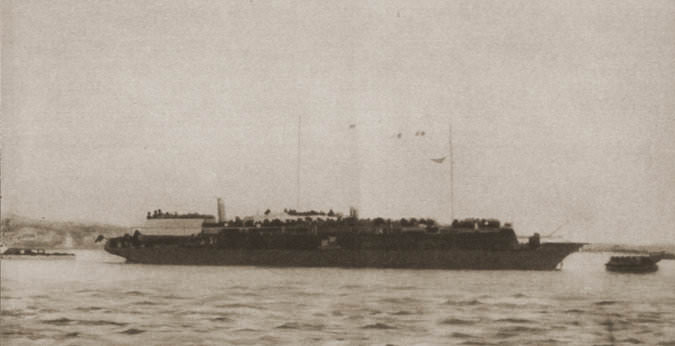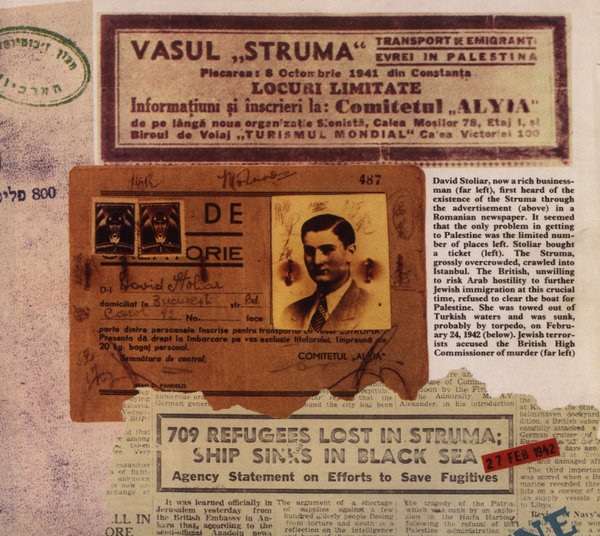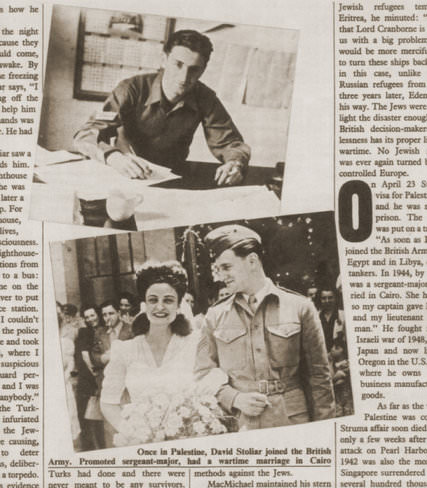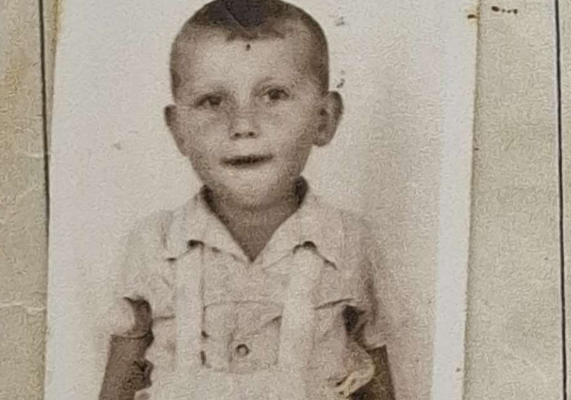(The death of David Stoliar, in 2014, received little attention outside Oregon, where he lived. The New York Times, which had prepared an obituary, learned of his death on Friday.)
 For more than a half-century, David Stoliar remained a silent witness to the worst civilian maritime disaster of World War II, the only survivor among nearly 800 Jews fleeing the Holocaust in Romania aboard a refugee ship that was barred from Palestine, interned by Turkey for months, set adrift without power and torpedoed by a Soviet submarine in the Black Sea in 1942.
For more than a half-century, David Stoliar remained a silent witness to the worst civilian maritime disaster of World War II, the only survivor among nearly 800 Jews fleeing the Holocaust in Romania aboard a refugee ship that was barred from Palestine, interned by Turkey for months, set adrift without power and torpedoed by a Soviet submarine in the Black Sea in 1942.
The sinking of the overloaded ship, a 150-foot steamer called the Struma, was a calamity compounded by Britain’s refusal to admit the refugees into Palestine and by Turkey’s 71-day quarantine, ending with the vessel being towed out to sea. The coup de grâce was fired by the submarine as the ship lay dead in the water seven miles offshore.
The doomed voyage of the Struma might have been a forgotten footnote to Holocaust history had it not been for Mr. Stoliar’s survival and his willingness years later to attest to the indifference and brutal decisions that put Palestine out of reach and led to the deaths of hundreds at the hands of nominal allies against Hitler.

The ID card of David Stoliar, the sole survivor of the Struma, which was carrying nearly 800 Jews fleeing Romania. Credit United States Holocaust Memorial Museum
Mr. Stoliar died on May 1, 2014, at his home in Bend, Ore., at the age of 91, his wife, Marda, said. News of his death was not widely reported, although a short item appeared in The Oregonian. The loss of the Struma, and Mr. Stoliar’s survival, were largely unknown until the turn of the century, when he spoke to a New York Times reporter.
The war in Europe had been underway for two years and Jews in Romania, their numbers swollen by refugees from Czechoslovakia, Austria and Hungary, were perishing under the nation’s fascist Iron Guard. Thousands hoped for passage out of Constanza, Romania’s port on the Black Sea, and through the Bosporus to Palestine. Their desperation was ripe for exploitation.
On Dec. 11, 1941, the Struma left Constanza with more than 790 Romanian, Bulgarian and Russian Jews — the number is still disputed — crammed into a squalid, leaky former cattle boat with bunks stacked 10 high, little food or fresh water, no kitchen and only eight toilets. There were no life preservers and just two small lifeboats. The crew of 10 were mostly Bulgarians.
Passengers paid up to $1,000 each, gouged by a charlatan who lied about the ship’s seaworthiness and visas, which were never provided. Mr. Stoliar’s father, a textile manufacturer, paid his passage. When the engine failed a few miles out, the captain of a passing tug repaired it in exchange for the passengers’ wedding rings, their last valuables.
Three days later, as the Struma limped toward Turkey, the engines failed again. Turkish tugs towed it into the Bosporus, the divide of Europe and Asia. Neutral Turkey, whose leaders feared angering either Britain or Germany, interned the Struma offshore while its fate was considered. Istanbul’s Jews donated food, but conditions onboard deteriorated as talks dragged on.
Britain, which had control of Palestine, limited Jewish immigration to avoid antagonizing the Arabs, and refused to let the passengers continue without visas. Ten were allowed to disembark in Istanbul: a woman who suffered a miscarriage, and nine others helped by an American oil executive, the Jewish Agency in Palestine and a Turkish Jew who aided refugees.
Finally, the Turks cut the Struma’s anchor, towed the ship back into the Black Sea and set it adrift. It was spotted the next day by a Soviet sub, identified years later as SC-213. Its commander had standing orders from Stalin to sink all neutral ships in the Black Sea to prevent supplies from reaching Germany.

Snapshots of Mr. Stoliar that appeared in The Sunday New York Times: at his office in Cairo, and after his wedding in Cairo. Credit United States Holocaust Memorial Museum
Snapshots of Mr. Stoliar that appeared in The Sunday New York Times: at his office in Cairo, and after his wedding in Cairo. Credit United States Holocaust Memorial Museum
Despite the target’s benign profile, a torpedo was fired at it dawn on Feb. 24, 1942. In a gray overcast, it struck amidships with an explosion that tore the Struma apart.
Most of the passengers and crew went down with the groaning ship in 250 feet of water. But scores more, including Mr. Stoliar, 19, who had been asleep in a deckhouse, were hurled into the sea with a rain of debris, mostly planking from the shattered deck.
After years of silence, Mr. Stoliar told the story in 2000 in an interview with Douglas Frantz, then a reporter for The Times.
“I was one of the lucky ones who was blown up into the air, and I fell into the sea,” Mr. Stoliar said. “When I came to the surface, there was nothing except a tremendous amount of debris and many, many people swimming in the water. It was very, very cold, and we had a hard time moving our feet and our hands.”
Mr. Frantz and Catherine Collins later recounted the sinking in a 2003 book, “Death on the Black Sea.” Mr. Stoliar told them he saw people screaming and thrashing in waves strewn with kindling. Many were clinging to a partly submerged section of the wooden deck, with cables and twisted metal from the ship’s railing attached to it.
He swam to the group, still clad in his heavy leather jacket, grabbed the railing and looked about at the terrified faces, shivering and sobbing in the cold. There was nothing to do but hang on. Hours passed and the cries gradually faded as people succumbed to hypothermia and exhaustion. Some floated off, others slipped into the deep.
One man lost his grip, grabbed Mr. Stoliar by the collar and dragged him under. But Mr. Stoliar broke free and regained his hold as the man sank out of sight. Soon birds appeared, flying over the corpses. As the dead drifted away, the decking grew lighter and rose in the water. Mr. Stoliar, a strong youth, dragged himself on top.

David Stoliar, in an undated handout photo from the family, was quiet for decades.
In the afternoon, the Struma’s first mate, Lazar Ivanof Dikof, floated by on a door. Mr. Stoliar pulled him onto his raft of wreckage. He told Mr. Stoliar of seeing the torpedo’s approach. In the numbing cold, they were surrounded by floating bodies. No one else appeared to be alive as night fell, and in the morning Mr. Dikof, too, was dead.
Alone now, Mr. Stoliar thought of giving up. He took out a jackknife to slit his wrists, but his fingers were too numb to open the blade. A short while later, about 24 hours after the Struma had sunk, a large ship appeared in the distance. He waved frantically, and saw figures on deck waving back.
Soon a rowboat approached. He was pulled aboard, wrapped in blankets and taken to a Turkish fishing village. His hands and feet were frostbitten. He was hospitalized in Istanbul, then jailed for six weeks, apparently to keep him from the news media. Referring to the Turks, he recalled, “I was the only witness to their inhumanity, really, from the beginning to the end.”
David Stoliar was born in Kishinev, Romania, on Oct. 31, 1922, the son of Jacob Stoliar, a Jewish textile manufacturer in Bucharest. His parents were divorced when he was 10, and he lived with his mother in Paris for several years.
In 1936, he returned to Bucharest and finished high school. He wanted to become an engineer, but the war intervened. He was taken for forced labor, digging trenches. As brutality against Jews spread, his father tried to save him by arranging his passage aboard the Struma.
For months the ship’s sinking became a rallying cry for Jews around the world. It generated protests, a general strike in Palestine, death threats against British officials and responses by Turkey and Britain that voiced regrets but denied responsibility.
Mr. Stoliar reached Palestine eventually and joined the British Army’s Jewish Brigade in 1943, serving in Egypt and Libya. He also fought with the Israeli Army in the 1948 war of independence. He became an oil executive in the early 1950s and lived in Japan for 18 years.
In 1945 he married Adria Nacmias. They had one son, Ronnie. His wife died in 1961. In 1968 he married Marda Emslie. Besides his wife, he was survived by his son and a granddaughter.
Mr. Stoliar moved to Oregon in 1971 and later retired. For decades he said nothing about the Struma, whose sinking was largely forgotten, noted mainly in scholarly books. But interest was revived in 2000, when Greg Buxton, a Briton whose grandparents had died onboard, organized a successful search for the vessel, which they photographed.
Mr. Stoliar spoke to newspapers and magazines and appeared in a 2001 documentary, “The Struma,” by the Canadian director Simcha Jacobovici. “For 58 years, no one asked me about the Struma,” he said, “and I felt that no one cared. I carried the memories in my head as if it happened yesterday.”
Originally published HERE.







